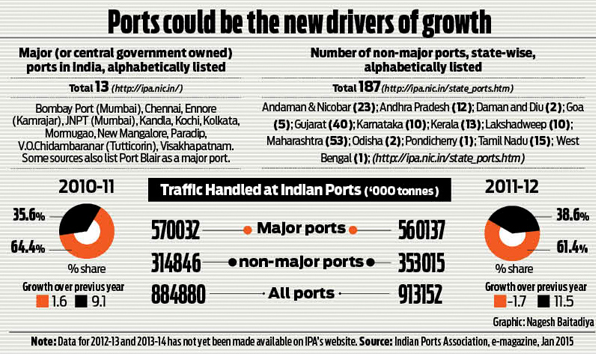R N Bhaskar
1 June 2015
On 25 March 2015, the Union Ministry of Shipping announced a revised vision of the Sagarmala concept that Prime Minister Vajpayee talked about more than 15 years ago. Among other things, it introduced – for perhaps the first time in India’s history – a “port-led direct and indirect development and to provide infrastructure to transport goods to and from ports quickly, efficiently and cost-effectively.”
The government stated that the Sagarmala Project would aim to develop “access to new development regions with intermodal solutions and promotion of the optimum modal split, enhanced connectivity with main economic centres and beyond through expansion of rail, inland water, coastal and road services.”
Translated, this meant that the government would now use India’s ports as the new hubs to catalyse economic development.
In many ways, the present government was only adding the finishing touches to a concept first embarked upon by the NDA government in early 2000. It may be recalled, that encouraging the development of non-major ports was undertaken then, and measures were introduced to allow foreign direct investment (FDI) and domestic private investments into this sector. A similar facility was also extended to investors willing to set up railway linkages between ports and the main rail network.
These were the policies that allowed private ports like Mundra, Dahej, Pipavav, Dhamra and Vallarpadam to plan large expansion projects. Had it not been for such measures, India’s export-import trade could have got badly crippled. This is because much of India’s international trade – 95 per cent by volume and 70 per cent by value — is carried out through maritime transport.
In fact, as the chart alongside shows, it is the non-major ports that have stolen the thunder from central government-owned major ports. During the past decade and a half, non-major ports have carved for themselves a 38.6% share of India’s port business, and are growing at a healthier rate of over 10% more than the country’s major ports.
The Modi government now wants to push the envelope further. His government has already spoken to the chiefs of all major ports and has advised them to be prepared to take up economic development of the coastline for about 100 km on either side of each port. The government plans to extend such a mandate to private (non-major) ports as well.
One of the things that could get announced shortly is the development of marinas and modern jetties across India’s coastline. It will not be surprising, therefore, if a marina is allowed to come up every 50 km or so along the country’s coastline. That would allow luxury yachting and holiday cruises to finally take off in India in a very big way. Each marina would in turn promote restaurants, holiday resorts, facilities for maintenance, and refuelling of boats and yachts, besides a vast array of ancillary services that invariably come up at all holiday resorts – right from transport and taxi services, to the emergence of small shops that cater to the everyday needs of visitors.
Unfortunately, none of these can be embarked upon right away. For one, the government will have to modify the existing CRZ (coastal regulatory zone) rules. But modifying such rules makes sense only if the land acquisition rules are changed first. Obviously, the government will need to build roads and railway tracks to connect many of these small port destinations to the arterial road and rail networks.
That is possibly what the government means when it stated in March this year that “The Sagarmala initiative will address challenges by focusing on three pillars of development, namely
(i) Supporting and enabling Port-led Development through appropriate policy and institutional interventions and providing for an institutional framework for ensuring inter-agency and ministries/departments/states’ collaboration for integrated development,
(ii) Port Infrastructure Enhancement, including modernization and setting up of new ports, and
(iii) Efficient Evacuation to and from hinterland.”
Once the laws are in place, expect major ports to begin work on creating new partners (possibly on a PPP basis) to develop around 2,600 km long India’s 7,500 km coastal territory (13 ports multiplied by 100 km on either side).
Also expect the non-major ports to kick in next. While key non-major ports like Mundra, Dhamra and Dighi might not number more than a dozen, they too will participate in developing another 2,400 km of coastal territory.
At a third level, expect many more of the non-major ports (totaling 187 across the country) to be picked up by other entrepreneurs, and scaled up to become either marinas, or small ports/jetties facilitating tourism and coastal cargo and people transport. Along with their upgradation, expect even more of coastal areas to get developed.
The good part about these plans is that none of the projects requires huge investments. A large port could cost in excess of Rs5,000 crore. But a marina or a jetty could cost anywhere in the region of Rs100 crore. This will be well within the reach of India’s teeming entrepreneurs, thus giving them more investment and business opportunities, even without the need for FDI. More than anything, the Sagarmala concept might unleash both economic development as well as harness the untapped potential of India’s marginalised millions.
To ensure that all this is embarked upon soon, the government has already stated that it will prepare within six months a National Perspective Plan (NPP) for development of what it calls Coastal Economic Zones. Expect new laws relating to shipping and maritime services to get introduced soon.
In other words, even though the government is looking at large scale investments for building highways and railway networks, expect a host of smaller projects to get unfurled in the coming year.
India’s age of coastal development could just be round the corner.
The author is consulting editor, DNA.
Read the original article here.
For more on India and its policies, click here.





































COMMENTS